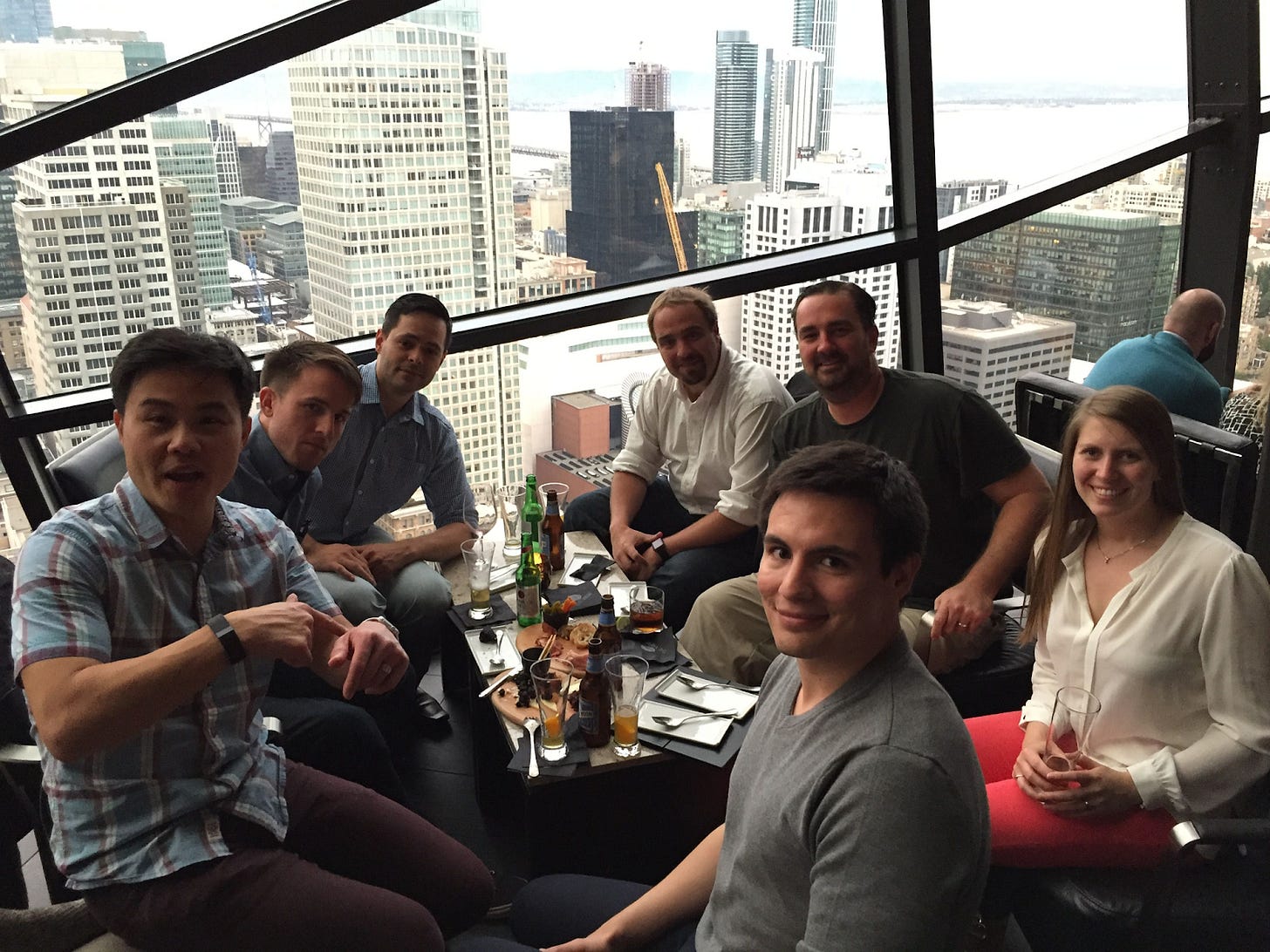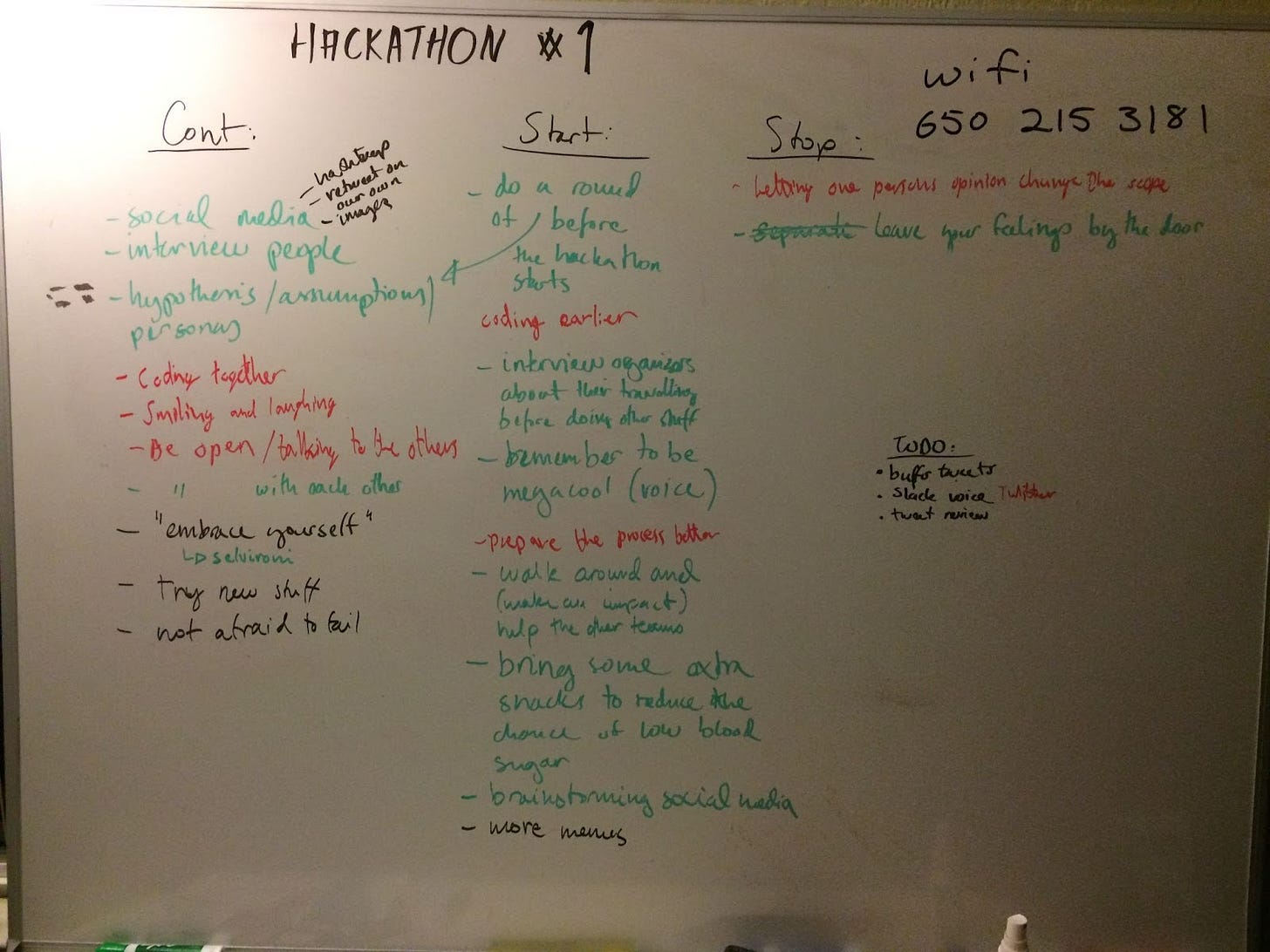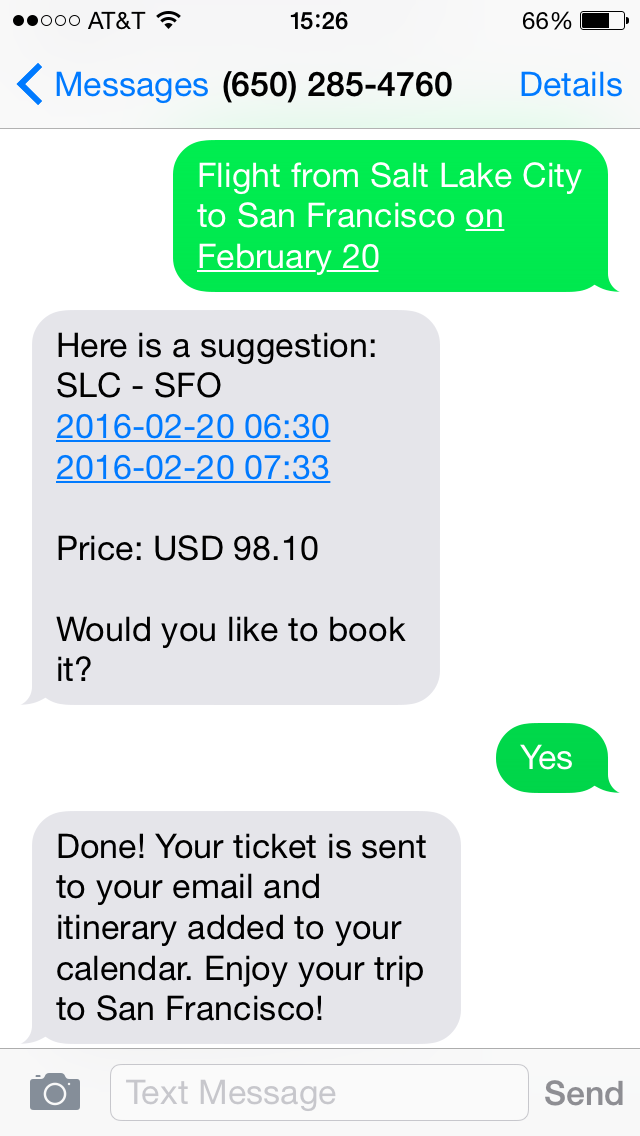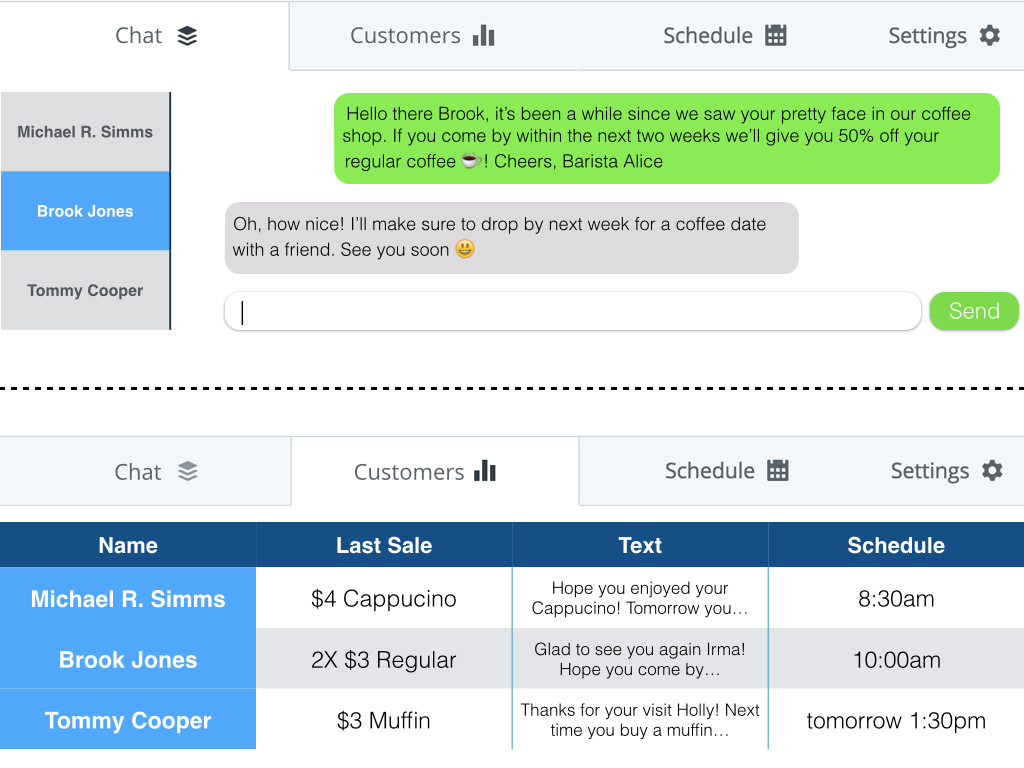Chasing Hackathons: From AI Travel Agent to Photo Management Adventures
Since 9 out of 10 startups fail, let’s do 10! This is the fourth post in the Megacool Series about the first three hackathons, which challenged our game plan.
The weekend couldn't arrive fast enough. We'd spent the first week in San Francisco getting settled, looking for more permanent places to live, finding a coworking space to work from, engaging our existing network, and starting to expand it. The days were long and intense, and we were ready for the weekend. Not to recharge (which would have been wise) but to return to the airport. Not to throw in the towel and go back home but to attend our first hackathon and kick off figuring out what our company would become.
Energy and inspiration were on top. With our recent successful startup journey with the mobile game studio Dirtybit, we felt untouchable and entered with the mindset that we'd crush this hackathon and win.
We'd clearly left our humble upbringing at the Scandinavian borders, only to face reality soon enough.
This is the fourth part of my Megacool startup journey. Here’s an overview:
Part 1: How the Megacool journey began
Part 3: Embracing Failure – How we tested 10 different startup ideas over 10 weeks
👉Part 4: Hackathon 1-3: From AI travel agent to photo management Aaventures👈 YOU ARE HERE
Part 5: Hackathon 4-7: The messy middle
Part 8: How we built our co-founder team
Part 9: From idea to live product
Part 10: Our bootstrapping hustle
Part 11: How we raised $1.6m in funding
Part 12: How we got acquired
Part 13: From Alpha to Acquired: The product, growth, and business model journey
Part 14: The emotional founder roller coaster
Part 15: The epilogue: Reflections on the whole journey
In the prior post (Part 3 Embracing Failure – How we tested 10 different startup ideas over 10 weeks), I explained why and how we ran ten hackathons to increase our chances of finding a successful idea.
In this post, I'll delve into our first three hackathons during the summer of 2015. We'll dive deep into the product ideas, exhilarating highs, humbling lows, and invaluable learnings from these adventurous pursuits. At the time, AI and Messaging, two really hot topics, inspired our first hackathons. As we ventured forth, our confidence faced the ultimate test, unearthing challenges that demanded our attention. So buckle up!
Hackathon 1 – AVA: Your AI travel agent
It was Saturday morning, and Uber and Lyft were still in heavy price competition, allowing two bootstrapping founders to cheaply Uber down to the San Francisco airport (SFO) for the TravelHack hackathon.
A few weeks prior, my co-founder Nicolaj had reached out to a fellow Dane of one of the hottest AI startups at the time: x.ai, an AI scheduling assistant, unfortunately, a few years ahead of our current AI prime time. Nicolaj asked if there were other areas ripe for AI disruption. The founder responded that travel booking would be a great area to address.
As we prepared for our San Francisco move, we came across the TravelHack Hackathon and saw it as an excellent opportunity to attend with an AI travel booking idea, thanks to inspiration from the x.ai founder.
The problem we wanted to solve was to save people time when booking flight tickets. Our goal for the hackathon was to build a working prototype for one-step booking of tickets.
It was a two-day hackathon. Hackathon food is great if you subscribe to a SAD1; You live on cream cheese with bagels, donuts, and other sweet treats. I would only allow myself two donuts per day. I don't recall seeing healthy options at any organized hackathons we attended. I guess our minds were supposed to get slushy from poor air ventilation, poor hygiene from several of the other attendees, and constant sugar rushes.
We kicked off the hackathon with the Learn phase by doing user interviews. Since the hackathon was at the airport, it was the perfect opportunity to interview our assumed target audience: travelers spending waaay too much time booking flight tickets.
In the beginning, it was super awkward to approach people. We were on a wild quest, bombarding unsuspecting souls with our never-ending and scattered questions while clumsily switching between interviewing and note-taking.
Are you traveling for business or pleasure?
How did you book this trip? Tell me about the process.
How many booking sites did you use?
How much time in total did you spend on booking this trip?
What can be improved with the booking process?
What’s most important for you when booking a trip? Convenience, time, or price?
The people we interviewed were all lunging around the terminal and traveling for pleasure. We quickly learned that these people spent between 10-60 minutes each time they booked a flight.
Through the hackathon’s interviews and learning more about the space, it became clear that if you want to make money in travel, you must address business travel needs. And you don’t find business travelers lounging outside the lounges.
Our hypothesis, therefore, became: We believe that a long-distance business traveler wants a one-step booking process for traveling, which knows their preferences and saves them time.
Fueled with new knowledge, we built AVA, a text-based interface layer (SMS) for flight bookings. When I say we, this was really Nicolaj doing the programming and being familiar with what APIs we needed to access to hack something together.
While I have an equivalent engineering degree to computer science, my coding abilities could have been better as I'd barely dabbled with them outside my programming classes. After graduating, I focused on understanding our infrastructure and technical challenges sufficiently to discuss pressing topics and project management with relevant stakeholders. After starting Megacool, I wanted to improve my programming skills and spent time taking javascript, jQuery, and Swift courses. But I needed more time to bring my proficiency up to par to contribute outside basic website work. During this hackathon, we saw the first signs of programming as a bottleneck, with Nicolaj being our "only" programmer.
Thanks to heroic and fast iterations by Nicolaj, we had a working prototype at the end of the hackathon: You could send an SMS with a flight request (i.e. "I want a one-way flight from San Francisco to Los Angeles tomorrow") to a number handled by Twilio. Our server got the SMS body, parsed the information using NLP by a service called Wit.ai, and sent a request to Amedeus. The best option was returned to the user with an SMS.
I remember stressing to wrap everything up before the end of the hackathon and prepare the presentation. Despite our aspirations, we didn't win but were mentioned as "one to watch" and got the attention of the Amadeus representative, who wanted to set up a meeting and discuss a potential partnership.
Thanks to the interwebz, the presentation was recorded, and you can watch it here. In my journal that night, I wrote about how nervous I was and how I felt my heart pounding so loud that the audience could hear it. The nice thing about re-watching this painful recording eight years later is realizing how far my public speaking skills have come.
While the TravelHack Hackathon was a great learning experience, it most importantly became the catalyst for the rest of the hackathons we ran over the summer. It also humbled us as it introduced the first hints of uncertainty about what the fuck we’d thrown ourselves into.
That night Nicolaj sent me an article: “What do you suffer for?” I wrote the following in my journal:
“You’ve got to stay calm and have patience. This will take time and won’t be a walk in the park…”
The next day was our first day at our new “home” for the next four years, Galvanize coworking. This was also the day we decided on our strategy to do ten hackathons to identify and continue with the most promising idea/problem of them all.
Although we'd completed the TravelHack Hackathon, we continued working on AVA for the rest of the week, armed with the new learnings and direction toward the business segment.
To reach this segment, we decided to run an AdWords campaign. We setup up a website where we'd drive traffic through ads. The website displayed a number to text for booking. However, neither of us had used AdWords before. Instead of asking someone to help us, we spent hours failing to set it up correctly and not getting valuable answers once we ran the campaigns.
To kill two birds with one stone, we got to know the other members of our new coworking space while interviewing and testing our prototype on them. Although not necessarily business travelers, they wanted to be as time efficient and cheap as possible when booking flights.
The final prototype allowed you to enter desired destinations, select what ticket to book, and get a confirmation message. Reflecting on the Build phase, we agreed that the prototype didn't have to be this "ready" to test our hypothesis. We could have faked more in the background.
As the week ended, we spent time reflecting on our learnings; US business travelers are more loyal to their frequent flier program than European business travelers, and until trust had been established, people wanted to see their choices when booking flights. People liked AVA’s simple SMS interface: "I don't have to download yet another app!"
Due to a lack of target user feedback, we couldn't confirm our hypothesis, but we felt like we were moving in the right direction and would continue testing and asking for feedback in the following weeks. It was easy to demo: pull out our phones and ask for a destination. We also had several meetings and interviews scheduled from referrals and with Amadeus about a partnership that could grant us API access to unlock an end-to-end booking experience.

The primary learning from this hackathon was how to do user interviews in the Learn phase:
It’s incredibly important that we smile when approaching someone. Similarly, we tried to get them to laugh within the first 30 seconds to ease the tension and potential awkwardness. It helped them open up.
Can we contact you when we’ve made further progress on this? (To collect contact details and to double confirm that this is a pain point for them)
Do you know of anyone else that we should speak to about this? (You’d be surprised by how powerful this question is. The best way to interview relevant users)
Do you have any other pain points/problems we should try to solve? (To help fill our backlog of ideas)
If we didn't know the person, we'd tell them that we were interviewing/testing on behalf of someone else. That way, they were more likely to give us honest feedback.
If we knew the person, we’d ask them to “kill our baby” to increase the chance of honest and direct feedback.
Hackathon 2 – Backlog: Taming your camera roll chaos
Morale was again high as we started the next Monday morning with a walk to kick off this week's "Photo Tagger" hackathon. The idea came from our need for better iPhone photo management: We often use the camera and screenshot feature, but everything ends up in the camera roll, and we forget it.
Instead of exploring the problem further, we jumped straight to discussing solutions and shortly had the following user cases in mind:
Use case 1:
Take a picture or screenshot
The app automatically suggests a tag in a notification pop up. You can edit the tag.
Sort your photos into folders.
Integrate with Dropbox, Slack, and Pinterest to faster share your photos.
Requirements: AlwaysLocation, iOS9 (text field notification).
Use case 2:
Take a picture of a business card
The app automatically asks if you want to add that person to LinkedIn.
Extensions: By using calendar and location, it can add info directly to your CRM-system.
We went on a walk to discuss how to expand on the Photo Tagger concept. And true to the startup roller coaster, we had already pivoted from Photo Tagger to a new concept titled Backlog by the time the walk was over.
Our goal for Hackathon 2 was to create a prototype we could use ourselves and demo to others to gather interest. We were approaching this hackathon from a selfish point of view: we knew we wanted this, so we'd focus on our needs and not worry so much about what other people thought. Our assumption was that other people had the same problem, so if we solved it for us and ended up using it daily, other people would too.
Hypothesis: We believe that a photo reminder app for people like us (early adaptors) will achieve structure. We will know this is true when we see people like us use it daily to organize their lives.
We planned to focus on personal reminders by photos and screenshots through gamification like Mailbox2 and later think of team integration, categories, and other APIs.
Drawing mock-ups turned into Keynote visuals and received feedback from a few people at Galvanize. Realizing that animations were needed for better comprehension, Nicolaj swiftly developed a basic v1 the first evening.
The second version allowed you to gesture on 30 pictures. It was clunky, and the 30 pictures would be re-generated as copies in your camera roll.
The third and final version had a working reminder function we could use.
As the week came to an end, our confidence was still high. We showcased it to a few people, and the response was really positive: "I need this now!" It was very motivating to hear.
While we had a working prototype, despite positive feedback as the weeks went on, we didn't spend more time enhancing the experience to a point where we'd truly adopt it and solve our needs. While lots of people agreed with the problem and need, no one gave us a clear indication that the need was so severe enough to monetize. Eight years later, there's still a need for better camera roll management with simple Tinder gestures in true Superhuman spirit. Maybe people's purchasing behaviors have matured for digital products enough for this to be revisited by someone?
The main lesson from this hackathon was that having only one true programmer created a bottleneck in achieving a functioning prototype. We aimed to build something that could work, so faking it with shortcuts wasn't an option. For future hackathons, we would aim to set realistic expectations and divide tasks accordingly: Nicolaj focuses on programming while I handle UI/UX and user interviews. However, this approach comes with a trade-off in knowledge sharing due to the rapid pace of development.

Hackathon 3: Reminders-as-a-Service (RaaS)
“I enjoy these roller coaster days. We’ve had several good discussions and are pushing ourselves out of our comfort zone.” Journal entry June 29th, 2023.
Like the prior week, we thought we would work on something different than what we ended up with. Messaging services were HOT during the summer of 2015, and Facebook Messenger had just enabled businesses to chat with users. Essentially enhancing the customer support experience.
The initial idea, Messaging-as-a-Service (MaaS), came from working with AVA and brainstorming for Backlog. MasS would be a platform for businesses that want to communicate directly with their customers with an AI-enhanced experience. After one of our walking discussions, we decided to shelve this concept until we knew if WhatsApp and Messenger would open up their APIs.
Back at the drawing board, I reminisced about my last visit to the hairdresser. The personalized experience made me wish they could remind me when to schedule my next haircut. A personal, timely, and friendly approach was necessary. We saw an opportunity to blend this personalization with Buffer's social media post buffering feature.
This week our goal was to create a working prototype to showcase and receive confirmation from at least one business that they would pay for it if we continued. We aimed to address the problem of enhancing the recurring customer experience and increasing business revenue.
Two of the hypothesis we wanted to test were:
We believe that RaaS for small B2C are interested in a solution like this. We will know this is true when we get an offer from a business to integrate with them.
We believe that a customer will buy a product/service if she gets a discount offer from a service she has used before. We will know this is true when she actually does it.
Inspired by the DoorDash founding story3, where they interviewed 200 business owners, we followed a similar approach and conducted user interviews to validate our product hypothesis. Despite the original goal of building a prototype, we ended up dedicating the entire hackathon to these interviews, with only a few mock-ups created towards the end to explain our product vision.
Despite interviewing 18 different businesses, we felt uncertain towards the end. We sensed we were onto something with RaaS, but we had yet to find the perfect approach. Neither of us felt overly passionate about the problem, and as the week came to a close, we took away some valuable lessons:
While DoorDash interviewed 200 business owners, we faced challenges finding the right people to talk to. Sometimes, the owners were too busy or absent, and we spoke with employees who couldn't fully represent the business's needs.
Encountering our first competitor, Demand Force, left us a bit disheartened. In hindsight, we should have focused on understanding their strengths and weaknesses from the user's point of view and evaluated if there were areas ripe for disruption.
Emotions were running like a roller coaster during this process. Feedback and outcomes affected our mood more than we anticipated.
Interestingly, roughly every fifth person we interviewed had their own business idea for us. It was a reminder that opportunities often come from unexpected places.
In retrospect, our vision for RaaS appeared to be a blend of Intercom and advanced rewards programs. We may have leaned too much towards retail and e-commerce, overlooking other potential customers with recurring services. A valuable insight for future endeavors.
The main lesson from this hackathon was that "everything else" also takes time. We weren’t able to focus 100% on the hackathon. Our days were filled up with lingering meetings for AVA, attending networking events, looking for a new apartment, and dealing with some incorporation and tax admin. The list piled on.
As we concluded the first three hackathons, exhaustion set in. Our passion was stronger for AVA and Backlog, but AVA faced challenges with necessary API access, while Backlog lacked a clear path to a billion-dollar potential. Uncertainty crept in, and I began to fear whether we'd ever discover something compelling enough to pursue. Doubts about our strategy lingered. Would we find the product idea that would make our company?
Continue reading the next part here: Hackathon 4-7: The messy middle
A huge thank you to everyone who helped make this essay better: , , , and Nicolaj Broby Petersen 🙏
Standard American Diet
Mailbox was an email client and the precursor to Superhuman. It made it super easy to get to inbox zero with only a few swipe gestures. It was unfortunately shut down later that year, despite Dropbox acquiring it for $100m a few years earlier.


















You sure did impress, I'm surprised to hear THack 2015 was your first hackathon! You weren't the only nervous one... it was also my first time being the representative.
Oh I admire people who can do Hackathons. I barely function with less-than-ideal sleep. I can't wait to read the next essay, along the journey of the makings of your company. Thanks for sharing, Aurora!